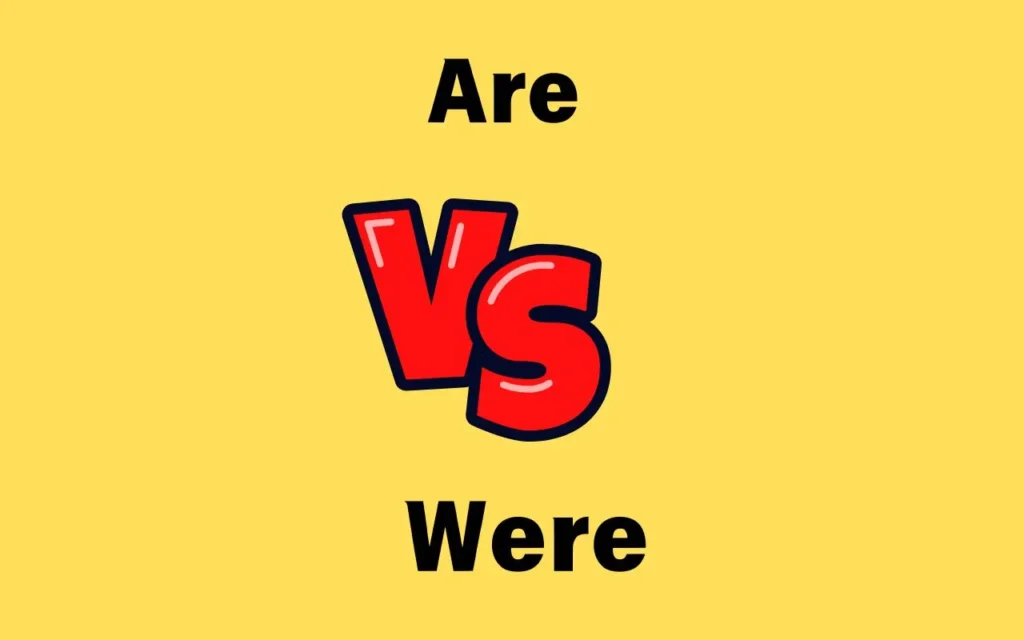Last updated on April 29th, 2025 at 10:53 am
When learning English, one of the most important elements to master is the verb “to be.” It’s essential for forming complete sentences and expressing both the present and past.
The confusion between “are” and “were” can be especially tricky for English learners, but once you understand the rules and practice using them, it will become second nature.
In this article, we’ll break down everything you need to know to confidently use are and were in American English grammar.
Understanding the Verb “Be”: A Brief Overview
The verb to be is one of the most fundamental and versatile verbs in English. It’s used to describe existence, state of being, and to form various tenses. The verb has different forms based on the subject and tense:
- Am (used with the subject “I” in the present tense)
- Is (used with singular subjects in the present tense)
- Are (used with plural subjects or the pronouns “you” and “we”)
- Was (used with singular subjects in the past tense)
- Were (used with plural subjects or the pronouns “you” and “we” in the past tense)
Understanding these different forms is essential because the correct usage of are and were depends largely on the subject of the sentence and the tense you’re using.
Confused about when to use “are” or “were”? Learn the difference between these verbs, including their usage in present and past tense, as well as tips for common mistakes.
The Present Tense of “Be”: When to Use “Are”
In the present tense, are is used primarily with plural subjects or the pronouns “you” and “we.”
- Examples:
- “You are amazing.”
- “They are ready for the test.”
- “We are going to the store.”
In these examples, are helps link the subject to the complement, whether it’s a description, an action, or a state.
Examples of “Are” in Sentences
Here are a few more examples to show the versatility of are in the present tense:
- “My friends are coming over later.”
- “The dogs are playing in the yard.”
- “You are a great listener.”
- “The books are on the table.”
These sentences highlight are being used with both plural nouns (friends, dogs, books) and the pronoun you.
Using “Are” with Plural Nouns and Pronouns
Are is almost always used with plural nouns and pronouns to show that multiple subjects are involved. This helps indicate that the action or state is happening with more than one person or thing.
- Plural Nouns:
- “The children are excited for the weekend.”
- “The cars are parked in the driveway.”
- Pronouns (We, You, They):
- “We are planning a trip.”
- “You are all invited to the party.”
- “They are studying for their exams.”
Using are correctly with plural subjects is key to mastering the present tense in English.
“Are” as an Auxiliary Verb in Progressive Tenses
In addition to being used as a linking verb, are also functions as an auxiliary (or helping) verb in progressive tenses. These tenses describe actions that are ongoing or in progress. When are is paired with the present participle (the verb ending in “-ing”), it creates the present progressive tense.
- Examples:
- “She is studying for her finals.”
- “They are playing soccer right now.”
- “I am reading a great book.”
In these sentences, are helps convey the idea that the actions are happening right now or in the present moment.
Exploring the Past Tense: The Correct Use of “Were”
When shifting to the past tense, were replaces are and is used with plural subjects or the pronouns you and we.
- Examples:
- “They were excited about the new movie.”
- “You were supposed to finish the project yesterday.”
- “We were at the park all afternoon.”
Unlike are, which expresses the present, were links the subject to a state or action in the past.
Examples of Using “Were” Correctly in Sentences
Using were correctly depends on recognizing that it refers to actions, states, or conditions that occurred in the past, often involving more than one subject.
- “The team were tired after the long match.”
- “We were waiting for the bus when it started raining.”
- “They were upset about the canceled event.”
In each example, were helps convey that the action or state is entirely in the past.
Customary Grammar Rules for “Were”
While were is typically used with plural nouns and the pronouns you and we in the past tense, there are some specific rules and usages to keep in mind:
- Use of “Were” with the Subjunctive Mood: In hypothetical or wishful statements, were is used even with singular subjects. This is known as the subjunctive mood.
- Example: “If I were you, I would take the job.”
- Example: “I wish she were here right now.”
- For all plural subjects and “you” in the past tense:
- “They were at the concert last night.”
- “You were the best player on the team.”
Common Mistakes and Confusions Between “Are” and “Were”
Even though the rules seem clear, many people still mix up are and were in their writing and speech. Here are a few common mistakes:
Mixing up Singular and Plural Forms
- Incorrect: “She were late for class.”
- Correct: “She was late for class.” (singular subject)
Using the Wrong Verb for the Tense
- Incorrect: “I wish I are a better singer.”
- Correct: “I wish I were a better singer.” (subjunctive mood)
Subjunctive Mood Usage of “Were”
One of the trickiest areas of grammar for were is its use in the subjunctive mood. In conditional or hypothetical situations, even singular subjects require were rather than was.
- Example: “If he were here, he could explain everything.”
- Example: “I wish she were more interested in this topic.”
The subjunctive mood helps express wishes, suggestions, or hypothetical situations.
Practical Tips to Remember the Difference Between “Are” and “Were”
- Check the Tense:
- If the action is happening right now, use are with plural subjects or “you” and “we.”
- If the action took place in the past, use were with plural subjects or “you” and “we.”
- Consider the Subject:
- Are goes with plural subjects and “you” in the present.
- Were goes with plural subjects, “you,” and “we” in the past.
- Remember the Subjunctive Mood:
- If you’re expressing a hypothetical or wishful statement, use were even with singular subjects.
FAQs
When should I use “Are” in a sentence?
Use “are” when referring to a plural subject in the present tense or when using the pronouns “you” and “we.”
When is it correct to use “Were”?
Use “were” for plural subjects or the pronouns “you” and “we” in the past tense, or in the subjunctive mood for hypothetical situations.
What’s the difference between “are” and “were”?
“Are” is used in the present tense with plural subjects, while “were” is used in the past tense or for hypothetical statements, even with singular subjects.
What is the subjunctive mood with “Were”?
The subjunctive mood uses “were” to express hypothetical or wishful situations, such as “If I were you, I would do it.”
Why do people confuse “are” and “were”?
Many mix up these verbs because they sound similar, but “are” is for present tense, while “were” is for past tense or hypothetical cases.
How can I avoid mistakes with “Are” and “Were”?
Remember that “are” is for present tense and plural subjects, while “were” is for past tense, with special cases for the subjunctive mood.
Conclusion
Mastering the difference between are and were can significantly improve your English grammar skills.
While are is used in the present tense with plural subjects and “you” and “we,” were is reserved for the past tense, and in certain cases, it’s used with singular subjects in the subjunctive mood.
By following the rules and practicing with these examples, you’ll soon be able to use are and were with confidence.





